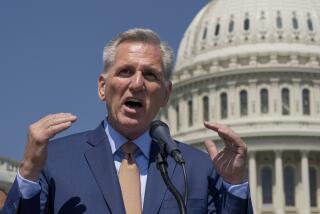National Debt Clock Goes Dark--or Is It Just Snooze?
- Share via
NEW YORK — It was a sign of the times. And so, too, is its demise.
New York real estate developer Seymour Durst conceived the idea of a National Debt Clock in the late 1980s, and put it up near Times Square in 1989.
“It was developed, erected and maintained by my father to focus attention on the soaring national debt,” said Douglas Durst, now president of his father’s business. “It has served its function.”
And so, the younger Durst presided over the clock’s plug-pulling Thursday--a testament to big budget surpluses and a renewed sense of fiscal responsibility in Washington.
As the federal debt ballooned in the early 1990s, the total on the electronic clock climbed so fast that the last several digits were just a blur. The clock had to be turned off for a few months in the mid-’90s when the debt was increasing so fast it crashed the computer that calculates it.
“I always used to look at it and watch the numbers churning forward. It was a little scary,” said Jennifer Erday, a law firm employee who craned her neck to watch as the clock was turned off.
On Thursday, the numbers moved slowly--and downward. The national debt has actually decreased since the beginning of the year, what with Treasury surpluses and the first buybacks of government debt in 70 years.
The total debt is now less than $5.7 trillion, including nonpublic debt that represents IOUs to the Social Security system.
The government has said that the entire $3.4 trillion of the debt held by the public could be wiped out by 2013 under current projections for budget surpluses.
In its last moments, the sign read: “Our national debt: $5,676,989,904,887. Your family share: $73,733.”
“It’s not fair,” said Harvey Gerson of Livingston, N.J. “We watched it getting higher every day for years and now we should be able to enjoy watching it get smaller.”
A red, white and blue curtain was drawn over the sign, but the clock will remain in place “in case things go awry and the debt once more soars,” Durst said.
“And the way I hear politicians talking,” he added, “I’m afraid I do foresee having to turn the clock on again.”
More to Read
Inside the business of entertainment
The Wide Shot brings you news, analysis and insights on everything from streaming wars to production — and what it all means for the future.
You may occasionally receive promotional content from the Los Angeles Times.










